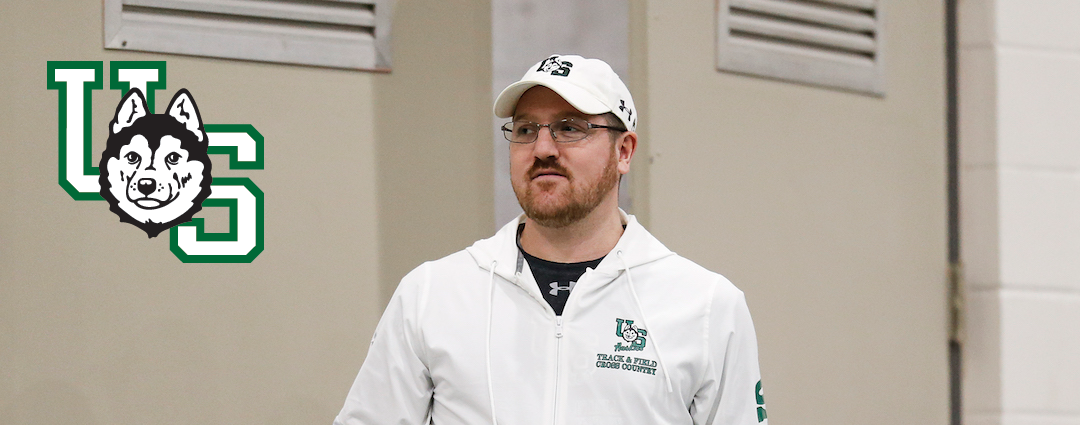Welcome to the very first edition of The How To Fix Shin Splints podcast and interview series. This series will cover – you guessed it – shin splints and how to fix and avoid them. We will interview professionals in different areas in the world of athletics. From strength coaches, to track coaches, to basketball, volleyball, and other sport specific coaches, to physiotherapists and sports medicine doctors. All of this with the aim of providing you the latest and most useful information surrounding shin splints, related overuse injuries and how to stay pain/injury free.
Our first ever guest is Jason Reindl. Jason is the head track and field and cross country coach at the University of Saskatchewan. He was named Canada West female track & field coach of the year in 2018, 2019, and 2020. He was named Canada West male track and field coach in 2019. Jason has also coached with the Canadian National team in three separate years, 2017, 2018, and 2019. Jason holds a degree in Human Kinesiology and a masters degree and graduate certificate in high performance coaching and technical leadership. And just these past few weeks, one of the athletes Jason has been coaching placed fourth at the Canadian Olympic trials.
The list goes on and on.
I think it is safe to say that Jason is a great person to talk to about all levels of track and field and cross country athletics and that he knows how to coach and train athletes properly, keeping them injury free.
So without further ado…
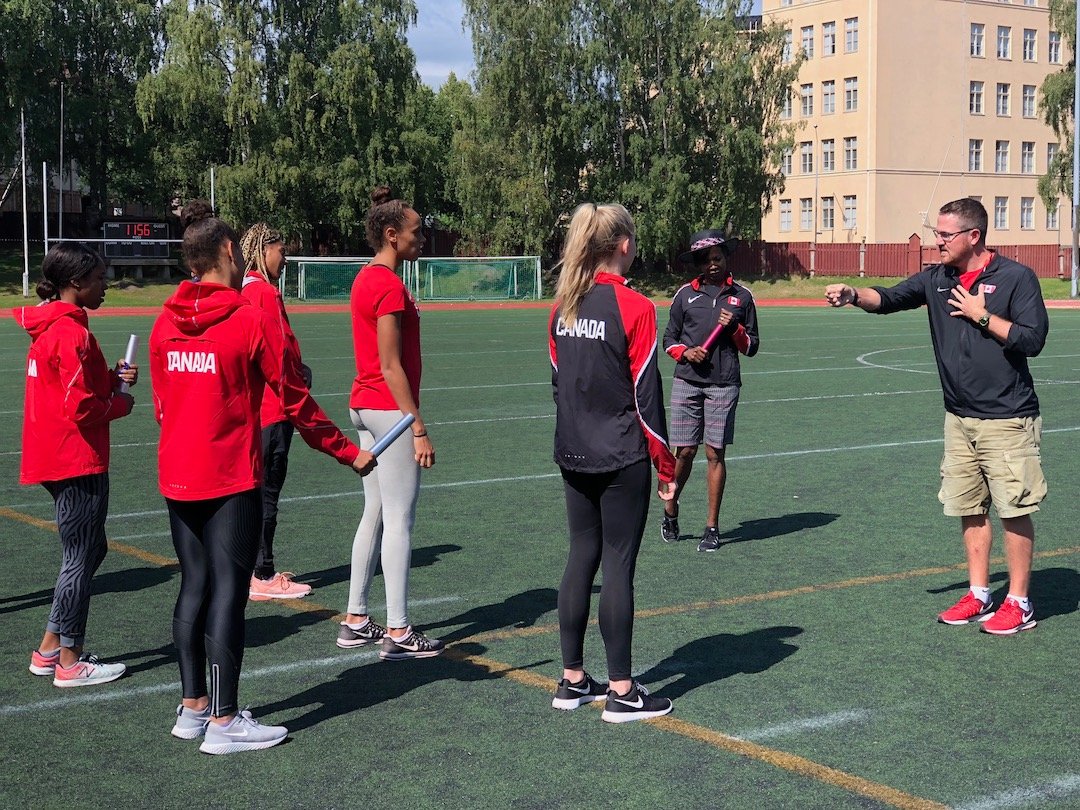
Jason (right of photo) working with national team athletes at the 2018 World U20 Championships
I wanted to jump right into things with injury prevention, I think that’s a great place to start. Especially for people looking to avoid shin splints in the future and other overuse injuries below the knee. I would imagine because you obviously work with all the university students who do varsity that a lot of people come to you unprepared for the season or for that level of competition. How do you end up augmenting their training to make sure they don’t get injured with the new training and more intense competition?
Yeah, you know, so that itself is a huge topic and huge area. I guess from a common-sense approach, we do every athlete, every program, every year is very similar in a sense of health is number one. We try and educate the athletes through the first couple of weeks of practices, explaining how you might have been from a high school program, a club program, a multi-sport program and are now finding your way specifically into track and field or cross country and it’s going to be a journey. That journey is going to involve a little bit of a rollercoaster ride at times, but we try and instill that there are no bad things – no negatives.
If we can get into their heads and get the understanding that it’s okay to take a rep off or a set off or have an extra day off, we’re already ahead of the game. But that initial education piece touches on footwear, how our program works, how we train, how we rest, recover, and develop to get better. Also, that everyone is going to have some aches and pains along the way, and if you are open and honest and communicate with your coach and our support Husky health team, it will be minor and short-term, and we’ll work through it.
It’s the silence and the “I’m fine, I’m fine, I’m fine” where situations become more than a couple days of rest, recovery, and adjustments.
You mentioned that you have the support staff around. Does your team specifically have strength coaches that work with the athletes?
We do on campus. The majority of our tack/XC athletes do not work with those individuals, however. We keep it in-house so to speak because of the nuances of every event. The jumps group is going to want to focus a little bit more on explosive power and dynamic movements in terms of take-offs, the endurance athletes definitely don’t want to hypertrophy and put on any mass, and everything in between.
Our staff coaches look after the writing of the programs and then we try and build off that and tap into our other resources for assistance on the questions that come up and try and say “well, if your back hurts, what are the other exercises we can do to still get the training effect we are looking for?”.
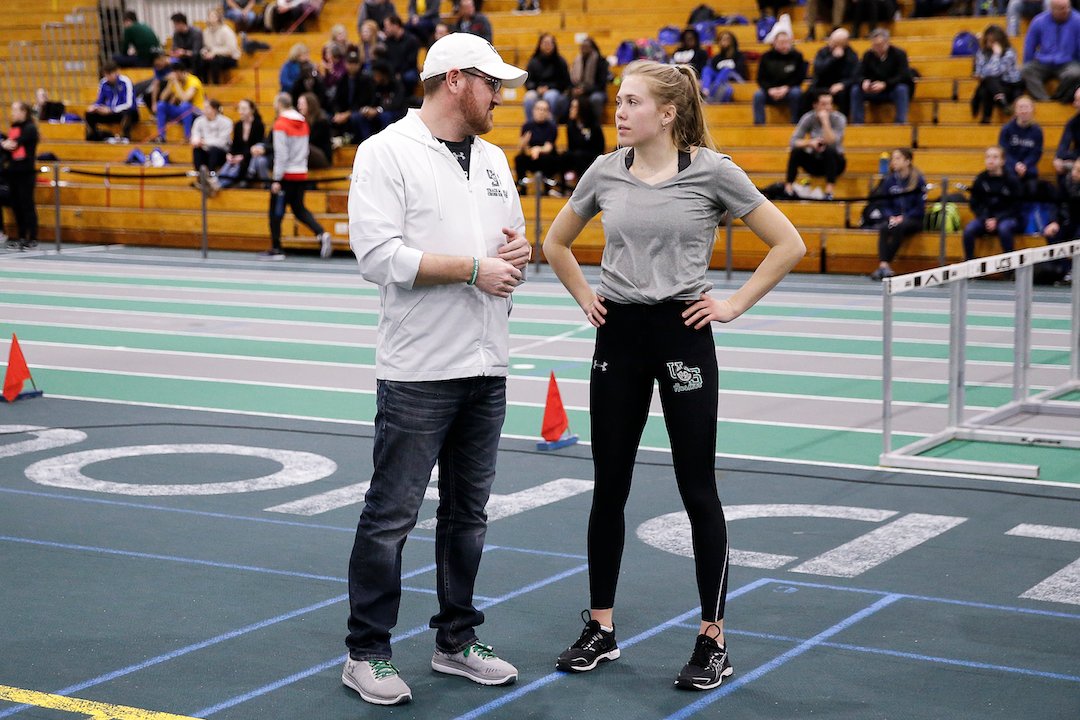
Jason (left) discussing competition plans with Huskie athlete Leadan Chartier.
When an athlete comes in and they join your XC program and they’re not used to the volume how do you taper running versus other additional training?
Right off the bat our normal rule of thumb is about two thirds. So…any first-year that comes into our program, we usually hold them to two thirds of the volume. If it’s three sets of 3x1km, they’re going to do two sets. And while we definitely don’t hold ourselves to that rule as something we can’t deviate from. It does help us over the first couple weeks to explain to them that it is better to have more consistent workouts at a higher quality than huge ebbs and flows and crashes. You might get a great workout on Monday but if you emptied the tank on Monday – Tuesday, Wednesday, Thursday, etc., are going to be a little bit harder for you.
If you have a XC athlete and they are part-way through the season and they have an injury, such as shin splints for example – do you have a special protocol for shin splints specifically?
Our standard go-to is we initially start becoming detectives. Our first go-to is we are going to look at their footwear and make sure that their shoes themselves are appropriate, that they haven’t been worn for over a year or two plus. We explain again that given the mileage, we are in the 3-4 months range, depending on the individual – their footwear needs to be replaced.
After that, we will look at the footwear and see if they have any abnormal gait patterns. This isn’t to say that we are professional “shoe analysis people”, but one of our lead assistant coaches, Jamie Epp, works at our local running stores and actually works in the footwear industry and fits people on a daily basis, so we can kind of look at wear patterns.
From there, we will definitely look at adjusting volumes and intensities, and assess the severity of the injury at the moment. And if we know it’s not shoes and a couple days off, and that it requires our physiotherapy Husky Health Team then we will refer onto them and continue on the process on a more specific basis. What are the limbs doing, what are the internal/external rotations, pronation, and supination, look at ankle mobility and joint stiffness, and it becomes this evolving puzzle.
The more complex it becomes, the more we are trying to simply figure out what the issue is. But that is a general summary of what our process is – we start watching their mechanics, watching them run, look at their footwear, figure out how long this has been building up. Again, if we have open and honest communication very early on, we can usually address things and its usually minimal deviations from the plan. But sometimes, young adults don’t share as openly as we’d like, and we need to twist the knife a little more to get the details out of them.
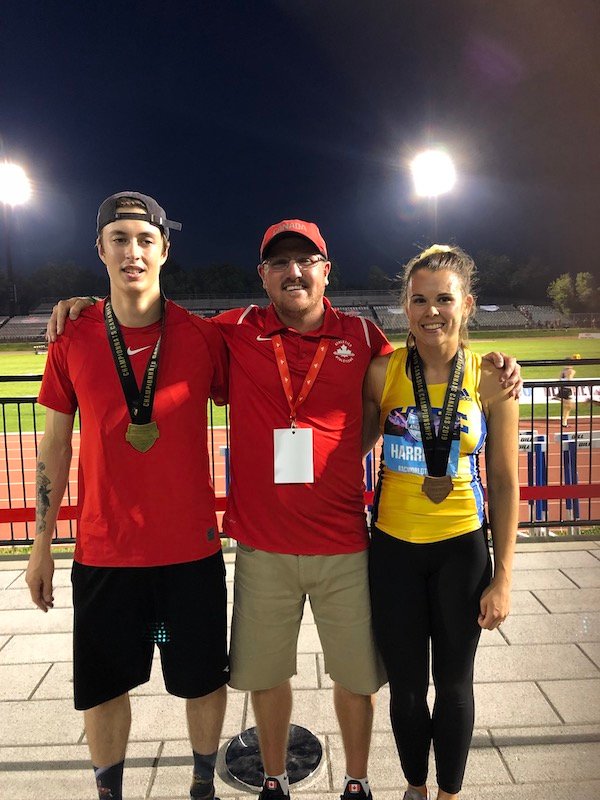
Jason (middle) with 2019 Canadian Championships Medalists – Payne Wylie U20 Gold & Michelle Harrison Senior 100m Hurdles Bronze
When you work with endurance athletes, you mentioned that hypertrophy is a little bit dangerous for them in a way because they don’t want to put on pounds as that will just be a nightmare. But they still need to be strong otherwise they can’t compete properly. Could you run us through a generic strength program or exercises would be for one of your longest distance runners?
For sure. But Ill just pause and say on the footwear front, the biggest thing that we try and communicate is running shoes are very specific for running. They are not the same as a cross-trainer or basketball shoe, soccer, etc., and not to say that a big box retailer that’s found in the mall isn’t going to get you, but to those employees…yeah, a shoe is a shoe and they are going to pull whatever off of the shelf and it is a kind of a buyer-risk-reward scenario. In my experience with the middle-school, high-school multi-sport kind of athlete, costs are always something that do come up, and with the inflation a decent pair of running shoes these days is starting at about $150 up to $200 plus. 20 years ago my running shoes were $95 and its just the way things are going.
But one of the metaphors we try to use here is if you invest a dollar for every hour you spend training or running – that’s your budget. Looking at it like this, a new pair of shoes isn’t that costly. But weekly physio appointments and the pain of not being able to run and do your recreation and do what you are trying to improve upon – that’s going to have a far greater mental cost. So, we try and explain it in ways, but I guess it’s a kind of catch-22 where it’s not as simple as this and a perfect pair of shoes but about 90% of our club kids who come through the development stream, they are wearing basketball shoes at practice. And you know their shins start to hurt. We have to say, “you know mom and dad, I guess we have to explain that basketball shoes aren’t designed to do 5x200m around a track.” Just nuances of sport.
But getting back to that other question on the strength side of things.
It’s pretty similar to any normal strength program. We split it up into upper-body and lower-body. Or single-leg, double-leg. Try and bring in rotations and push and pull, and all the different movement patterns. And then we just try and manipulate the set and rep combinations. We are going to do bench-press and it’s going to be light and vary between narrow, normal, and wide grips, dumbbells, bilateral, unilateral and we keep it below 70% in terms of a 1RM. Or we keep it at +85% knowing that the majority of hypertrophy comes in that 70-85% range where you can get your rep range into that 8-15 range. So, you can do either 20 reps easily or maybe 5 reps. We found that we are able to develop holistic strength and not put on pounds, but just improve overall athleticism.
A general look at exercises is we would do some squats, might do deadlift, bench, pull-downs, pull-ups, single leg push press to develop some stability through the chain, maybe some low-level jumps along the way. Band exercises, more “physio” activation type stuff. And you know, our endurance athletes lift. We don’t shy away from it. They’ll never win a weightlifting competition against our speed/power athletes, but they feel comfortable and engaged and know that for 2-3 times a week at 45 minutes, they’re in the gym that this is complimenting their running workouts/aerobic work.
I’m a little surprised you said the reps were so low for endurance athletes, a lot of what we come across and see people doing is between 20-40 or even higher depending on what background they come from – westside barbell kind of goes into extremes into what they do with endurance training. Do you test things like this during the years – how often do you change programs and realize that “oh we can change this or implement this” etc?
It depends on the exact time of year we are looking at. We usually go through 2 cycles in the fall. Four to six weeks depending on when exactly we start and end. If we start September 1st and carry through to October, and then phase 2 is going to be for the remainder of the season. That will be just based off our competitive calendar. A conference, then a week off, nationals, etc., and then the majority of work we are going to do is during a buffer period of mid-November through December.
Then in the new year if they are a track athlete they are now competing and have 12 more weeks of their indoor season. Then depending on the calendar, they will go through 2-3 more cycles. Then April through August, they will get 6 cycles. But it is more flexible during this time as they are not with us, they are all over Canada and we are just trying to provide them the programming that allows them to train and develop and be ready to go. It tends to be a bit more general. But there is flexibility built in for if they email us and say “hey, I can’t do X at my local gym but I can do Y, Z, etc. how can we supplement and adjust?”
Usually, it’s not that difficult to adjust. We are looking at posterior chain, glutes and hamstrings, here is the menu-base we can pick and choose from, what do you think you can do given what you have access to at home, etc.
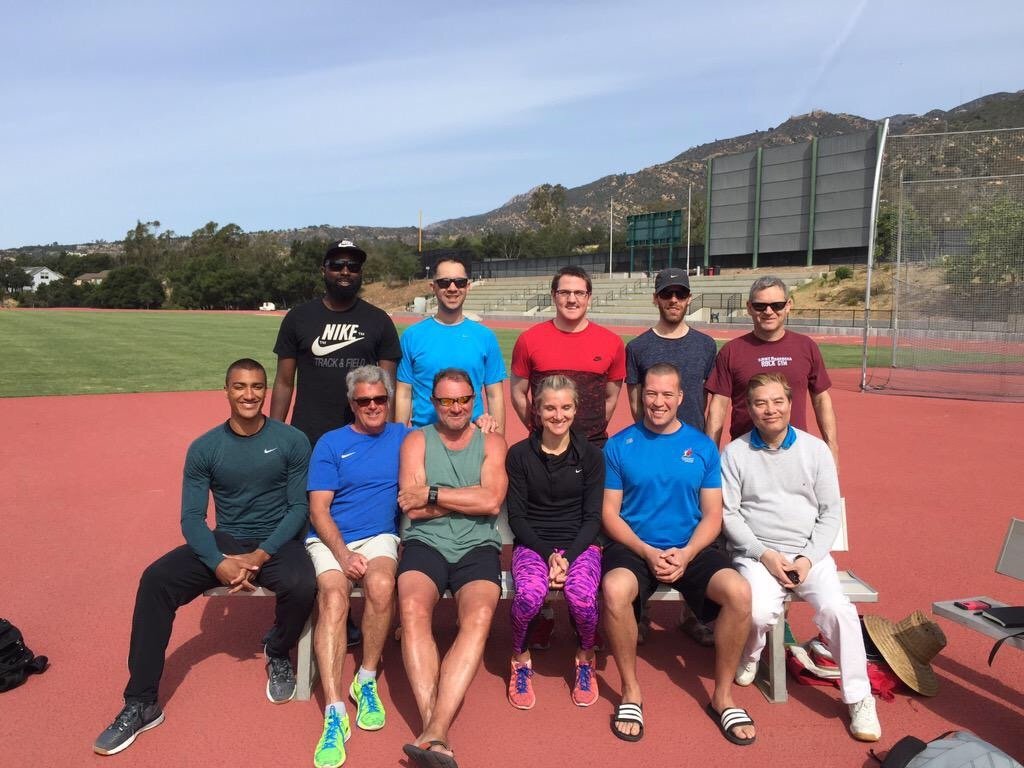
Jason (back row middle) at a Combined Events Coaching Mentorship with lead coaches Harry Marra and Les Gramantik
Your athletes go through a lot of cycles during the year. How different is each cycle? One will be for absolute strength vs speed and power – how does that work for you guys?
Yeah so, small changes. Sometimes there are consistent themes across 2 or 3 of the cycles. They bleed into each other, and there might be a 2-week wash period and then a full new program. Or each cycle will be completely different. And this is where the discussion and daily communication comes in to play.
We have some athletes that hate to do pullups. Others love it. Whether you love them or hate them, we can supplement them for a similar movement, like a lat pulldown instead. The outcome is the same and it just becomes a matter of figuring out what works for the athlete.
When they are in competition for those 12 weeks roughly, you are just doing maintenance at that point I would imagine. You aren’t trying to do anything new right?
Pretty much, yeah. Maintenance, injury prevention, general athleticism – not really attacking anything too much. And with our endurance athletes specifically, we have a very small window where we look at cross-country indoor and outdoor where we can actually attack something like absolute maximum strength. That window of opportunity is very small and sometimes we’ll have an athlete go 2 years without even touching that area.
They are still getting stronger, and they are still getting faster – they are still getting better at their sport. So does it matter that their hex-bar deadlift only went up 5% over a long period vs 6% over a short specific period?
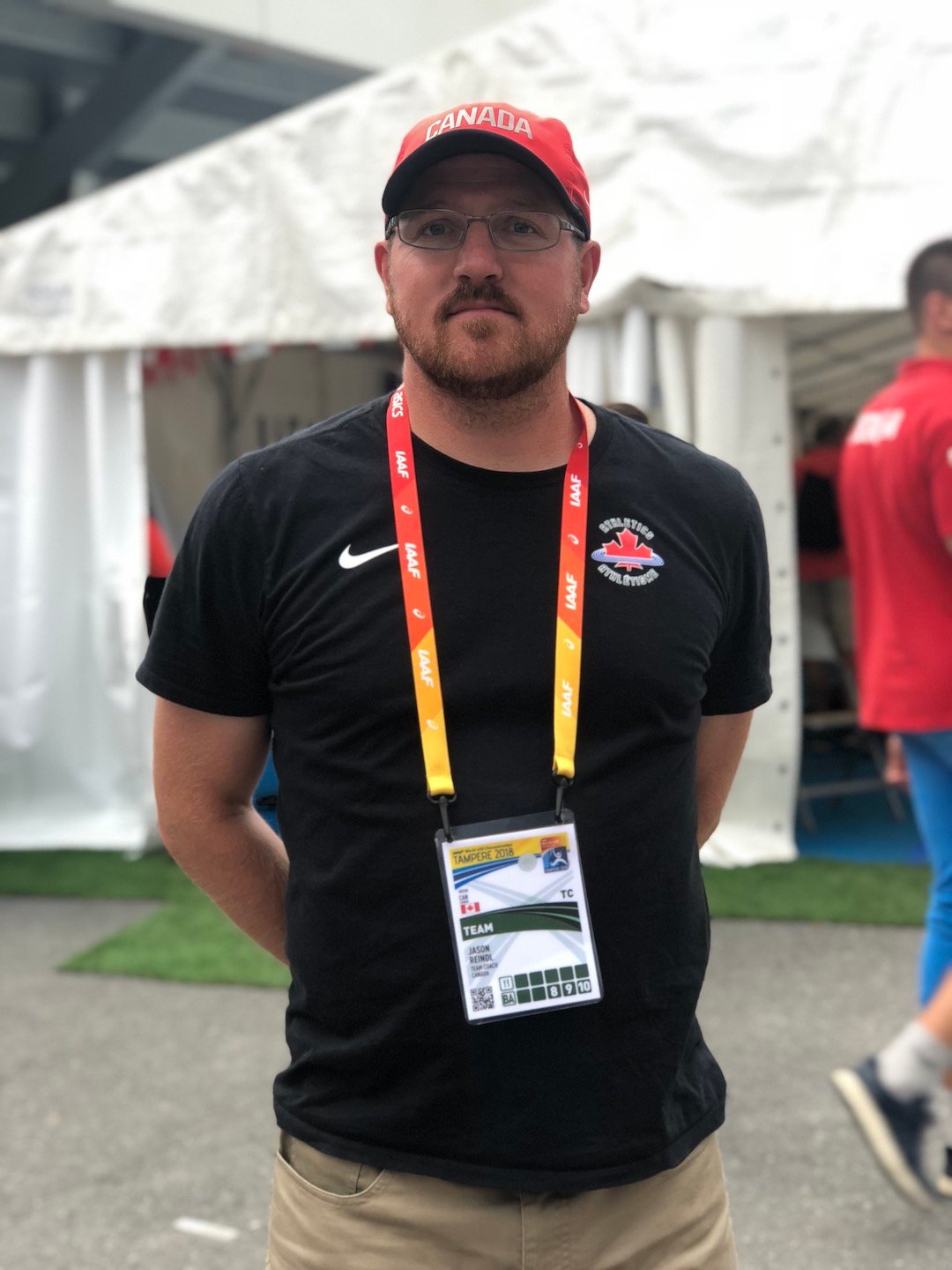
Jason at the 2018 World U20 Championships in Tampere, Finland
You mentioned injury prevention. How much of their time is spent between running, strength training, and mobility/flexibility? Because there are a lot of varying opinions on flexibility and stretching and whether it should be used or not…
We try and look at it from a common sense approach. We don’t need to be gymnasts. But we do need to be athletes. Our coaching staff has about a couple hundred years of experience between all of us. We all agree that athleticism trumps specific gains. If we have a team that is more athletic and more well-rounded and are more robust individuals, we feel more confident as a team.
We have a structured warmup protocol that the athletes use on a daily basis, then we have the workout – whatever it might be for the day – we go through a specific cool-down and mobility protocols. We build in a lot of band work, some med ball, core strength, various plains in motion, double-leg/standing/kneeling, and just try and develop the whole athlete. It works out to maybe 10-15 hours per week on average. Which works out to about 2 hours of full training per day.
If we just look at recovery tools we have, we have a couple pairs of normatec boots, ice baths, etc. That rest-recovery modality can easily surpass the amount of worktime you have. It just depends on how many tools you take advantage of.
Bringing it back around to youth development. When a new athlete comes to you, a lot of that stuff you mentioned is new to them and you taper back their volume almost automatically. I was sent something by another track coach (image below) – what is your take on volume for youth athletes for +3,000M events?
You know…in all honesty, I wouldn’t even define it at the start. I would personally look at 3 weeks of 3, 20-minute runs. Most kids have a smart device of some kind. Turn it on and go for a 20-minute run and then tell me how hard it was on a scale of 1-10. If it’s a 10/10 and they maxed themselves out, we are just trying to build over these 3 weeks that it gets a little easier as you go along.
Week 1, Day 1, they cover let’s say 4.2km and it was a 10/10.
If in week 3 they say, “I ran 5km and it was an 8/10”.
Well already, if they are healthy and happy, we are on the right side of the developmental pathway in terms of load and intensity, and getting things going.
I believe that if you start off and say “you’ve got to run 40km a week” and we attached a firm number to it. Now that will anchor our mindset and our abilities around this and if we don’t achieve it, we are a failure and are falling behind. I try, and what we try to promote here at University of Saskatchewan is that we aren’t going to put an anchor on you. We are just going to start running and doing some work, and as you become more comfortable and your fitness improves, we are going to do 3 running workouts and 2 bike workouts per week. We can then take out a bike and put another running in. Because if we start with 4-5 running workouts…shin splints, overuse injuries haha you know – the topic at hand.
And you know, this is what kind of excites me about the kind of work you are doing is that it is this vicious cycle. I live this and breathe this, and not everyone feels comfortable calling me or emailing me and asking me questions – or any of the other coaches. Sometimes people don’t know where to turn. So the more resources we have like this that are available, we can say “Here’s some info, we know that there are many roads to Rome. Don’t get tied down to any specific thing.”
I think I know the chart that you are talking about, and again, and you know…we can talk about someone who matures early at 14 years old. But even myself, I matured very late. I say I’m 5’10’’ now, but when I was 14, I was lucky if I was 4’6’’ and weighing 80lbs. Any volume a coach would have told me to do would have been a significantly different load on me than say one of my best friends who was 5’8’’ in Grade 8 and he is still 5’8’’ today.
This is where the charts and the nuances there can sometimes do more harm than good.
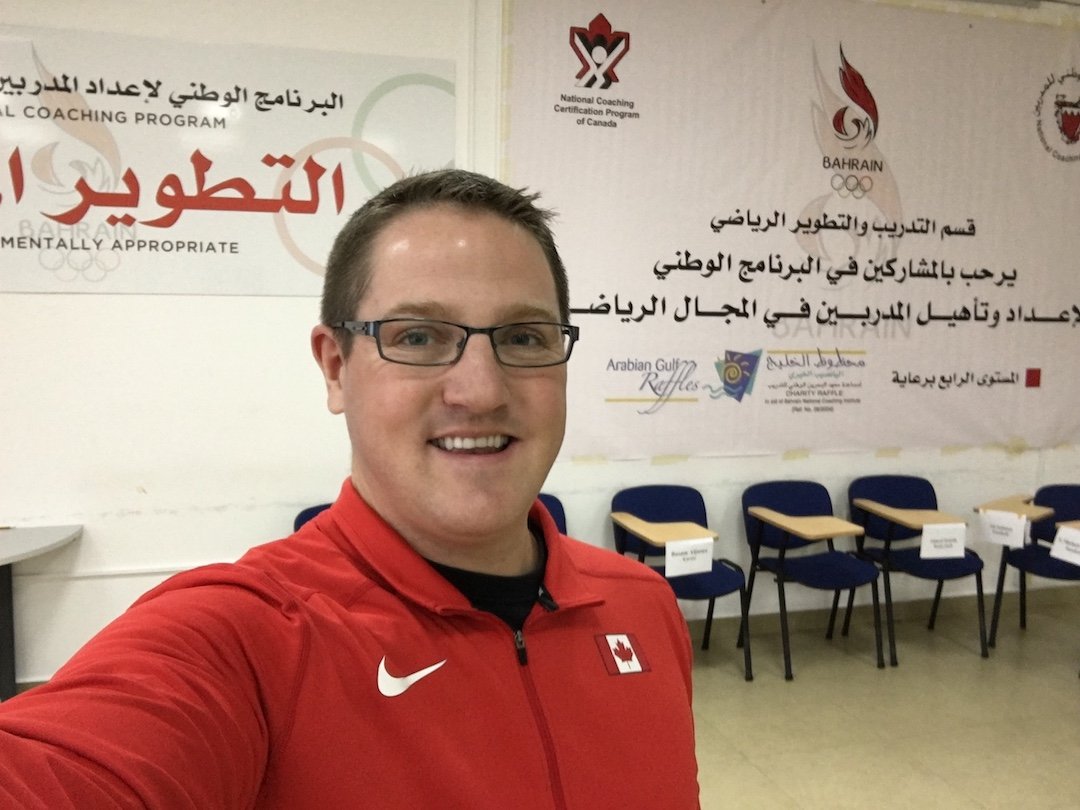
Jason taking a break from leading NCCP Performance Analysis for the Bahrain Olympic Committees Level 4 Coach Education Program
So, if there is a youth athlete listening to this where their coach is telling them “you need to do this, you need to do 60km a week” – how can someone deal with this?
Find a new coach. Hahaha, no…it’s tough. Today’s day and age, there is a ton of information out there and for every training plan that exists…and in the running circle this could be…Shalane Flanagan’s Marathon Prep Program. And we can see day-by-day, Running Room, Canadian Running, and all these things publish these. But they don’t realize that their pace is significantly different, their recovery, it’s their job, all these other aspects go into it.
My two anecdotal stories on this are, Cole Hocker of University of Oregon, who just qualified for the Olympics who pretty much had one of the greatest seasons in Oregon’s running history. He has recently come out and said that his success this year is based off the fact that his high school coach didn’t have them run over 35 miles a week. It was exceptionally low. Let’s Run and all the message boards are blowing up and asking “Could he have run better? Could he have run faster? Could he have run and won New Balance Nationals and all these other big high school events?” and I challenge and say why? He’s obviously fit, healthy, and winning everything, and is only 19-20 years old and just qualified for the US Men’s Olympic Team.
It’s not a question about being your fastest today. It’s about reaching your ultimate potential. That’s the part that people fall back on and say “more, more, more, more!”. This is my day-to-day life; I live and breathe coaching and running. But I myself am a very recreational runner. My 5 days a week, I try to get out and plod along the riverbank and keep my body as healthy as I can. But I will run 8k at 5’30’’km pace and its slow. But 2 days later Ill hammer a 5km and get closer to 4’20’’ or 4’30’’ pace. But if you ask me to go for double-days – no, my nutrition isn’t there, my recovery isn’t there, my sleep isn’t there, all these other things…
A lot of times what seems like the plan is great or the mileage is great, without introspection it can really set you up for difficulty and this is where I am all for the world of running and I wish more people ran and those kinds of things, but we need to start slow. We need to understand that even the most basic C25K program is still general. It is still not specific to you. If you are a 16-year-old who’s transitioning from basketball/volleyball/soccer and taking on more running because you want to win your city’s title; are you working? If you are working at McDonalds or have a paper route as a 16-year-old, that needs to be factored in. If you are also helping out around home, if you are taking IP classes that have more homework so you are getting less sleep…all of those things play a role. If they aren’t taken into reflection – you are kind of burning the candle at both ends. It becomes a question of when, not if, a setback is going to occur.
I’m really happy that you said that. That seems to be a lot of people’s pitfall when it comes to running, they don’t really factor in what their life is currently and what running is going to do. One of the things we have been looking into a lot recently is the idea of 10,000 steps a day. Speaking from personal experience, I became very sedentary. I was not moving nearly as much as I thought. I think that if people took their average steps per day over a long period of time would realize that the vast majority of people are nowhere near 10,000.
Then you think to yourself, I don’t do 10,000 steps per day – not even close. Maybe 4-5,000 steps. Then I start to run. You go from a walking impact and a low volume, to a much hard impact with running and a much higher volume as well. People need to slow down and take these things into consideration and really understand what it is they are getting into.
You mentioned the C25K, and personally I cannot stand those programs. The amount of people we see who make it to week 2 and suddenly have shin splints or some other overuse injury and are confused as to why they are suffering these things. But they tend to be overweight, have little to no experience running, don’t do activities in general, etc., but the expectations are they will be able to jump into a general running program that wasn’t designed for them.
Yeah, and then we can get into the mechanics and physiology of it. One of my favourite explanations is – let’s all go on our chests and start to do some pushups. Go onto the palm of your hand, then on the fingers and the heel of the hand. Your foot is exactly the same as your hand. So which one feels better? Right in the middle. Your feet are the same way.
The whole “sprint on your toes” thing, that’s trash. That’s from the 60’s and 70’s, that’s gone. Heel striking? Okay…easier on the body, and that’s why we are seeing shoes developed with these huge cushions. The majority of forces are supposed to be around the forefoot.
If we take this to 2 meters per stride. 200lbs individual. Every stride, we are hundreds and hundreds of pounds. We can factor in gravity, and all these things. But if you go for a 5km, you are going to be around 2,500, maybe 3,000 steps. With 200lbs every single contact.
There is a reason why I spend all day every day watching my athletes run and critiquing the way they stride. Looking at their shoes. Watching how they are rolling. Because if you are off by an inch – forwards/backwards – or you are pronating or supinating, multiplied by the individuals weight and the contacts they are going to have, it’s a recipe for disaster.
I’ve done a couple recreational marathons. It wasn’t my legs or lungs that went out. It was my poor posture in my hips, my back, and then my ankles. These were the things that were my recipe for disaster. That is the part where you are a little more sedentary, that below your knee has atrophied, you have no muscle there.
If I were to create a brand new C25K program, it’s going to be walk and bike. There’s going to be no running for the first three weeks. Then, once you are getting 10-15K steps in per day of walking or walk/jog-ish, with some more high-intensity bike we are going to introduce 1 day per week of running. Then 2 days a week of running. Slowly build that out. But you know, no one wants to play the long game in 2021. It’s all about instant gratification. People think if a 20-minute run is good, then a 60-minute run is better and that’s going to make me a better athlete! Haha!
But anyone who has gone for that big of a jump in their volume knows that their legs are toast, they are probably sorer…the snowball just continues to roll getting bigger and bigger.

